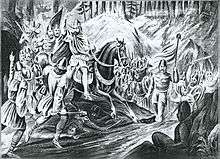Battle of Bar
| Battle of Bar | |||||||
|---|---|---|---|---|---|---|---|
 | |||||||
| |||||||
| Belligerents | |||||||
| Duklja | Byzantine Empire | ||||||
| Commanders and leaders | |||||||
| Stefan Vojislav | Michaelus Anastasii | ||||||
| Strength | |||||||
| vastly lower | 40,000 | ||||||
| Casualties and losses | |||||||
| low | 2/3 of army killed, 7 strategoi killed, 50 captured | ||||||
The Battle of Bar (Serbian: Битка код Бара) took place in 1042 between the army of Stefan Vojislav, the ruler of Duklja, and Byzantine forces led by Michaelus Anastasii. The battle was actually a sudden attack on the Byzantine camp in the mountain gorge, which ended in the utter defeat of the Byzantine forces and the deaths of 7 of their commanders (strategoi). Following the defeat and retreat of the Byzantines, Vojislav ensured a future for Duklja without imperial authority,[1] and Duklja would soon emerge as the most significant Serb state.[2]
In memory of this victory, 7 October is commemorated as the day of the Military of Montenegro.
Background
Prior to the war, Duklja and the other Serb principalities were subordinated to the suzerainty of the Byzantine Empire. However, around the start of the 11th century, Stefan Vojislav waged a series of successful attacks aimed at independence.
The Byzantine army, led by the dux Michael, moved towards Duklja in order to suppress the revolts, and they set up camp in the area near Bar. Byzantine historian John Skylitzes described their invasion of Duklja (in Latin translation by Immanuel Bekker):[3][4]
|
Servis, ut fertur, dedita opera cedentibus ac intrare eum sinentibus, neque de reditu solicitum neque iusto praesidio angustias occupantem. ita ingressus campestria direptionibus incendiisque vastabat. at Servi fauces itinerum ac praerupta insidere et reditum eius praestolari. |
|
Battle
The battle took place on the mountainous area between Bar and Crmnica after midnight, on October 7, 1042. Prior to the battle a man from Bar entered the Byzantine camp and spread false information about huge army causing panic among the Byzantines. Stefan Vojislav, along with three of his sons, led the Docleans into battle. Their army slowly moved down the hills along with shouting and blowing horns and trumpets to exaggerate their size. The Byzantines, trapped into the mountainous area, were caught unprepared and after heavy fighting were routed. Some historical records claim that two thirds of the Byzantine army had been killed. Byzantine historian John Skylitzes (1040–1101) claimed that 60,000 Byzantines participated in the battle, but these records are considered inaccurate. Most historians agree that there were about 40,000 Byzantines. Numbers of the Doclean army are unknown, but are considered to be largely inferior to the Byzantines. Vojislav dispatched 50 Greeks to tell the rest about it. The Strategikon described the outcome of the battle:[3][5]
|
ὁποῖον ἐποίησεν ὁ Τριβούνιος ὁ Σέρβος τῷ κατεπάνω Δυρραχίου Μιχαὴλ τῷ τοῦ λογοθέτου υἱῷ εἰς Διοκλείαν καὶ ἀπώλεσε τὸν λαὸν αὐτοῦ ἐπέκεινα τῶν τεσσαράκοντα χιλιαδῶν ὄντα. |
|
References
- ↑ Cedrenus II, col. 275,
- ↑ John Van Antwerp Fine (1991). The Early Medieval Balkans: A Critical Survey from the Sixth to the Late Twelfth Century. Ann Arbor, Michigan: The University of Michigan Press. p. 207. ISBN 0-472-08149-7.
- 1 2 George Ostrogorsky; Franjo Barišić, eds. (1966). Византијски извори за историју народа Југославије [Byzantine Sources for the History of the Peoples of Yugoslavia]. 3. Belgrade: Institute for Byzantine Studies of the Serbian Academy of Sciences and Arts. pp. 160–61, 210–11.
- ↑ Immanuel Bekker, ed. (1839). Georgius Cedrenus Ioannis Scylitze Ope. 2. Bonn: Impensis ed. Weberi. p. 544.
- ↑ Basil Wasilewski; Viktor Jernstedt, eds. (1896). Cecaumeni Strategicon et incerti scriptoris de officiis regiis libellus. Saint Petersburg: Typis Academiae Caesareae Scientiarum. p. 25.